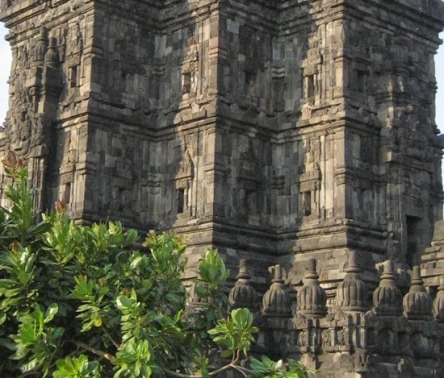Basic architecture of Prambanan temple construction is Wastu book Literature, which also contains about Hindu architecture. The layout of Prambanan temple follows the pattern of the Mandala with the hallmark of a very dominant Hindu. The original name of Prambanan temple is Siwagrha (Sanskrit), but the temple is more popular with the name Prambanan, because it is located in the village of Prambanan. Inspiration Prambanan Temple is Mount Mahameru that believed to be the abode of the Gods. The entire temple complex follows the model of the universe according to Hindu cosmology concept, which is divided into several layers of the realm, nature or Loka.
As in the Buddhist culture that inspired the construction of the Borobudur Temple, Prambanan Temple construction is also divided into three tiers zones, starting from the less holy to the most suc. Despite the different names, each of these Hindu concept has the Buddhist concept, which in principle is almost the same. Land either horizontally or vertically floor plan is divided into three zones.
Three levels of development zones contained in Prambanan temple is;
Bhurloka (in Buddhism: Kamadhatu),
Is part of foot in the Prambanan temple, in Hindu term in building the temple foot called as Kamadhatu. Bhurloka is the lowest realm of mortal livings, humans, animals, and demons. In this realm of humans is tied with less lust, passion, and a way of life that is not holy.
Bhuwarloka (in Buddhism: Rupadhatu),
It is part of the body at Prambanan temple symbolizes human life in midle nature . In Hindu belief is the nature of this middle class of saints, sages, ascetics, and lesser gods. According to Hindu belief of these people are those who start in this human nature began to see the light of truth.
Swarloka (in Buddhism: Arupadhatu),
Swarloka is the highest temple (roof) which is a symbol in the Hindu faith. Those who occupy this place is the Gods in their beliefs. The gods are residing in a place called Swargaloka. Prambanan temple roof in the design premises mastaka a waterless models ratna (Sanskrit: gems), which is contained in the form of Prambanan temple is a modified form of wajra in Buddhist temples or thunderbolt diamond symbolizes. In ancient Javanese Hindu architecture, ratna is Hindu and for Buddhist called stupa, which serves as a waterless or mastaka (head) temple.
 |
| Source Image: Wikipedia |
A box of rocks or Pripih discovered during restoration, the bodies are found under the statue of Shiva. At the bottom of the main room there is a Shiva temple and a depth of 5.75 meters pripih stone coffin was found on a heap of wood charcoal, soil, and animal bones of victims. Inside this pripih are sacred objects such as sheets of gold inscribed with characters Waruna (god of the sea) and Parwata (mountain god). In this stone casket contained sheets of copper mixed with charcoal, ash, and soil, 20 ancient coins, a few grains of gems, glass, pieces of gold, and silver sheets, shells, and 12 sheets of gold (5 of them in the form of a turtle, snake dragon (cobra), padma, altar and egg).


